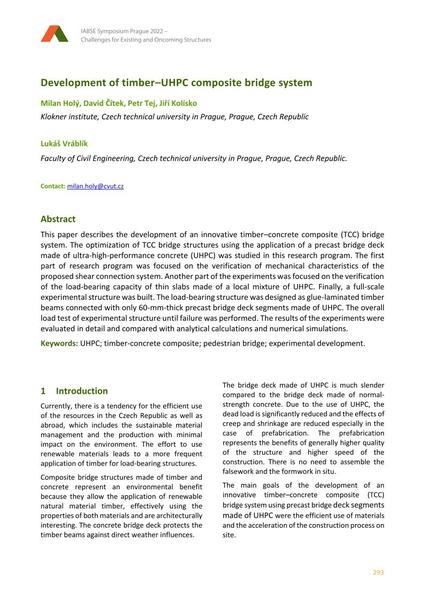Development of timber–UHPC composite bridge system

|
|
|||||||||||
Bibliografische Angaben
| Autor(en): |
Milan Holý
(Klokner institute, Czech technical university in Prague, Prague, Czech Republic)
David Čítek (Klokner institute, Czech technical university in Prague, Prague, Czech Republic) Petr Tej (Klokner institute, Czech technical university in Prague, Prague, Czech Republic) Jiří Kolísko (Klokner institute, Czech technical university in Prague, Prague, Czech Republic) Lukáš Vráblík (Faculty of Civil Engineering, Czech technical university in Prague, Prague, Czech Republic.) |
||||
|---|---|---|---|---|---|
| Medium: | Tagungsbeitrag | ||||
| Sprache(n): | Englisch | ||||
| Tagung: | IABSE Symposium: Challenges for Existing and Oncoming Structures, Prague, Czech Republic, 25-27 May 2022 | ||||
| Veröffentlicht in: | IABSE Symposium Prague 2022 | ||||
|
|||||
| Seite(n): | 293-300 | ||||
| Anzahl der Seiten (im PDF): | 8 | ||||
| DOI: | 10.2749/prague.2022.0293 | ||||
| Abstrakt: |
This paper describes the development of an innovative timber–concrete composite (TCC) bridge system. The optimization of TCC bridge structures using the application of a precast bridge deck made of ultra-high-performance concrete (UHPC) was studied in this research program. The first part of research program was focused on the verification of mechanical characteristics of the proposed shear connection system. Another part of the experiments was focused on the verification of the load-bearing capacity of thin slabs made of a local mixture of UHPC. Finally, a full-scale experimental structure was built. The load-bearing structure was designed as glue-laminated timber beams connected with only 60-mm-thick precast bridge deck segments made of UHPC. The overall load test of experimental structure until failure was performed. The results of the experiments were evaluated in detail and compared with analytical calculations and numerical simulations. |
||||
| Stichwörter: |
Fußgängerbrücke Holz-Beton-Verbund UHPC
|
||||
| Copyright: | © 2022 International Association for Bridge and Structural Engineering (IABSE) | ||||
| Lizenz: | Die Urheberrechte (Copyright) für dieses Werk sind rechtlich geschützt. Es darf nicht ohne die Zustimmung des Autors/der Autorin oder Rechteinhabers/-in weiter benutzt werden. |
||||

